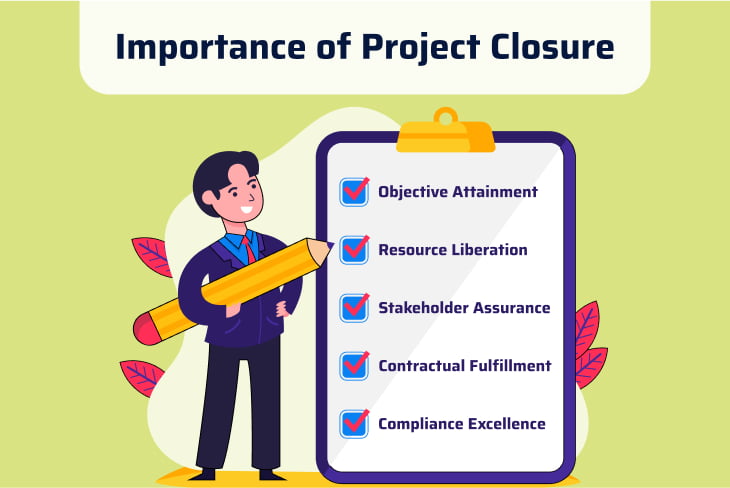Importance of project closure

- Project closure ensures that all project objectives have been met and that the deliverables meet the requirements specified in the project scope. It provides a formal acknowledgment that the project has achieved its intended goals.
- Furthermore, resources, including human resources, equipment, and budget allocations, are released after project closure. This ensures that resources are no longer tied up in the project and can be allocated to other initiatives.
- Formal closure allows for a comprehensive review with stakeholders to confirm that the project has met their expectations.
- If the project involves contracts with external vendors or partners, the closure phase involves fulfilling contractual obligations, settling payments, and ensuring that all parties are satisfied with the outcomes.
- Additionally, some projects may be subject to regulatory requirements or compliance standards. Project closure ensures that all necessary documentation and compliance criteria are met.
Steps of project closure
Project management teams should follow these processes to close a project and obtain client and stakeholder approval.
Execute tasks that need to be completed
At the completion of a project, unfinished pieces must always be finished. Make sure that lesser tasks and goals haven’t been forgotten as the major project deliverables will have been finished. This could involve any of the following:
- Additional resources and outputs.
- Project records and product manuals.
- Any instruction that must be given.
- After completion, a customer owns files and intellectual property, which have been moved.
- Sent and paid invoices.
- Are there any administrative duties that must be completed before beginning the project closing process?
Ensure project objectives are met
After tying up any loose ends, it’s time to review the project against the original brief or scope to see if the objectives were achieved. KPI and a host of other criteria are used to assess the success of projects. Most projects are evaluated based on a few key parameters at the top level:
- Did we meet the client’s expectations?
- Was the project closed on schedule and within budget?
- Does the client approve of the deliveries and is satisfied with the quality?
- Have the aims and objectives for business and operations been met?
Conduct handover meeting
One of the most beneficial aspects of the closure procedure is the debrief. Prior to speaking with the customer, try to schedule the internal meeting via phone or in person. Everyone involved in the project will be in agreement as a result. If something goes wrong during the project closing phase, it helps to know who bears responsibility for errors and how problems were fixed. During this period, project managers should review the whole process with the project team, including all significant milestones, from beginning to end.
Complete documentation
Often, all that has to be done at this point of project closure is to make sure the customer receives the documentation, files, and other assets as promised. Testing and training the client may be required during project closing for more complex deliverables, including software and applications.
Anything from software to a website must be explained to the client in its entirety. Long-term trust may be established through handovers. Having successfully completed one project will make it simpler to get more. Securing the next project from the same organization might be aided by a project closing report.
Utilize project management tools to simplify project closure
Utilizing project management tools can significantly simplify the project closing process.
- It helps to make sure that all tasks are marked as completed before moving to project closing.
- Leverage the communication and collaboration features of Alian Hub to ensure that team members are informed about the project closing process.
- Evaluate whether the project stayed within budget and if resources were allocated efficiently.
- Create checklists and templates within project management tools for the project closing process.
- Use survey tools or built-in feedback features within project management platforms to collect feedback from team members and stakeholders.
- Ensure that all reported issues are addressed before officially closing the project.
Conclusion
In conclusion, the project closure checklist is essential for ensuring that a project is successfully concluded and all loose ends are tied up. By systematically addressing each item on the checklist, project managers can confirm that all deliverables are completed, stakeholders are informed, documentation is organized, and the project is officially closed. This structured approach contributes to project success and provides a foundation for future endeavors by capturing valuable insights and lessons learned.

